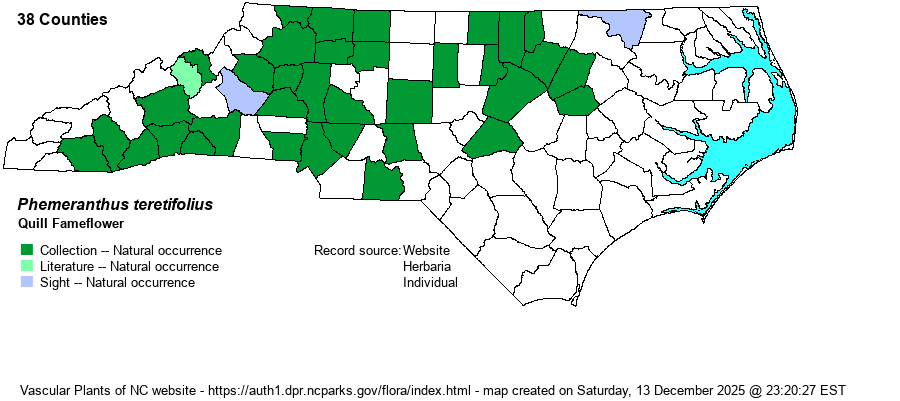| Author | (Pursh) Rafinesque | |
| Distribution | Essentially throughout the Piedmont, and in much of the Mountains, though mostly close to the Blue Ridge (and not toward the TN state line). One to a few records in the extreme western Coastal Plain.
This is a species of the Mid-Atlantic states of the Piedmont and lower mountains, also ranging west in the Cumberlands. It occurs from southeastern PA to most of GA and central AL.
| |
| Abundance | Localized to exposed rock outcrops, but can be fairly common at these sites in both the Piedmont and Mountains. Obviously, quite rare to absent in areas without exposed flatrocks, domes, and other sunny rock outcrops. Though found in at least 37 counties, the NCNHP's State Rank of S3 is suitable owing to the small acreage of the available habitats for it. | |
| Habitat | This is a requisite rock outcrop species. It favors the thin soil around granitic flatrocks, but it also grows on the edges of granitic domes and other outcrops, including mafic rocks. It tends to favor areas of some seepage, though moisture is not necessary. |
| Phenology | Blooms from June to September, but only for a few hours in the afternoon; flowers remain closed in the morning. It fruits soon after flowering. | |
| Identification | This is a familiar species to biologists spending time on flatrocks or exposed rocky domes, and it is usually a characteristic outcrop species. It has a clump of strongly ascending basal leaves, each very succulent and rather glaucous (pale green), terete (round in cross-section), but only about 2 inches long, with the tips being quite pointed. The very slender flowering stem grows erect to about 6 inches tall, with a handful of rose-colored flowers at the top. The spread flower of 5 elliptical petals is about 2/3-inch across, but as noted above, you need to see the plants in the afternoon to catch the open flowers. The flowers can range from pink to deep rose in color. P. piedmontanus, described only in 2011, is very similar, but check that species account for distinctions; it is known in NC only from one or two sites in southern Granville County (over diabase rock). | |
| Taxonomic Comments | Most older references named the species as Talinum teretifolium, but most newer ones have it moved into Phemeranthus.
| |
| Other Common Name(s) | Appalachian Rock-pink, Appalachian Fameflower, Rock-portulaca | |
| State Rank | S3 | |
| Global Rank | G4 | |
| State Status | | |
| US Status | | |
| USACE-agcp | | |
| USACE-emp | | |

